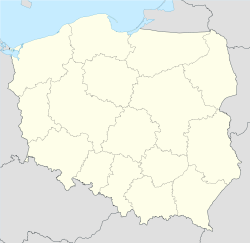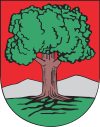Wałbrzych
| Wałbrzych | |||
|
|
|||
|
|||
 Wałbrzych
|
|||
| Coordinates: | |||
| Country | |||
|---|---|---|---|
| Voivodeship | Lower Silesian | ||
| County | Wałbrzych County | ||
| Gmina | Wałbrzych (urban gmina) | ||
| Established | 9th century | ||
| City rights | 1400 | ||
| Government | |||
| - Mayor | Piotr Kruczkowski | ||
| Area | |||
| - Total | 84.70 km² (32.7 sq mi) | ||
| Elevation | 350 m (1,148 ft) | ||
| Population (2006) | |||
| - Total | 125,773 | ||
| - Density | 1,484.9/km² (3,845.9/sq mi) | ||
| Time zone | CET (UTC+1) | ||
| - Summer (DST) | CEST (UTC+2) | ||
| Postal code | 58-300 to 58-309, 58-316 | ||
| Area code(s) | +48 074 | ||
| Car plates | DB | ||
| Website: http://www.um.walbrzych.pl/ | |||
Wałbrzych [ˈvau̯bʐɨx] (![]() listen) (German: Waldenburg) is a city in Lower Silesian Voivodeship in south-western Poland, with 125,773 inhabitants (2006). From 1975–1998 it was the capital of Wałbrzych Voivodeship; it is now the seat of Wałbrzych County. Wałbrzych is by far the largest city in Poland that does not itself form a separate county (powiat), having given up that status in 2003. (The next largest such town is Inowrocław, population 77,313.) Wałbrzych lies approximately 70 kilometres (43 mi) south-west of the regional capital Wrocław, and about 10 km from the Czech border.
listen) (German: Waldenburg) is a city in Lower Silesian Voivodeship in south-western Poland, with 125,773 inhabitants (2006). From 1975–1998 it was the capital of Wałbrzych Voivodeship; it is now the seat of Wałbrzych County. Wałbrzych is by far the largest city in Poland that does not itself form a separate county (powiat), having given up that status in 2003. (The next largest such town is Inowrocław, population 77,313.) Wałbrzych lies approximately 70 kilometres (43 mi) south-west of the regional capital Wrocław, and about 10 km from the Czech border.
Contents |
Etymology
The Polish name Wałbrzych comes from the Silesian dialect name (Walbrich) for the German name Waldenburg. Waldenburg means "forest castle".
History
The oldest historical records of the city date back to the 12th century. Between the 12th and 14th centuries, during the rule of the Piast princes from the Świdnica-Jawor (Schweidnitz-Jauer) lineage, the Książ Castle (Fürstenstein Castle), (in Polish Zamek Książ) and the Nowy Dwór fortress were built. Waldenburg was chartered in the 15th century. After the Piast family died out, Waldenburg became the property of the Silesian knightly families, initially the Schaffgotsches, later the Czettritzes, and from 1738, the Hochberg family, owners of the Fürstenstein Castle until 1941. Coal mining in the area was first mentioned in 1536. Waldenburg was transformed into an industrial centre in Eastern Germany at the turn of the 19th century, when coal mining and weaving flourished. In 1843 the city obtained its first rail connection, which linked it with Breslau (Wrocław). In the early 20th century a glassworks and a large china tableware manufacturing plant, which are still in operation today, were built. In 1939 the city had about 65,000 inhabitants.
The city was relatively unscathed by the Second World War, and as a result of combining the nearby administrative districts with the town and the construction of new housing estates, Wałbrzych expanded geographically. At the beginning of the 1990s, because of new social and economic conditions, a decision was made to close down the town's coal mines. In 1995, a Museum of Industry and Technology was set up on the facilities of the oldest coal mine in the area, KWK THOREZ. The 2005 the film Komornik was filmed in and around Wałbrzych.
Sights
- Książ Castle, the largest Silesian castle, the third largest castle in Poland behind Kraków's Wawel and the castle in Malbork.
- Chełmiec Mountain
- Palmiarnia
- Market square (1997-1999 renovated)
- Czettritz Castle (1604–1628)
- Alberti Castle (1801), housing the Municipal Museum
- St. Mary's (1305, ren. 1720)
- Protestant Church (1785–1788)
City districts
Polish name including date of incorporation into the city
|
|
Education
- Angelus Silesius State University in Wałbrzych [1]
- Oskar Lange Economical University in Wrocław [2]
- Wrocław Technical University in Wałbrzych [3]
- Ignacy Paderewski High School [4]
- Hugo Kołłątaj High School [5]
- Mikołaj Kopernik High School [6]
Media
Politics
Wałbrzych constituency
Members of Parliament (Sejm) elected from Wałbrzych constituency
- Zbigniew Chlebowski, PO
- Henryk Gołębiewski, SLD
- Roman Ludwiczuk, PO (Senat)
- Katarzyna Mrzygłocka, PO
- Giovanni Roman, PiS
- Mieczysław Szyszka, PiS (Senat)
Notable People
- Klaus Töpfer, German politician (CDU), born 1938 in Waldenburg
- Marcel Reif, German soccer journalist, born 1949 in Wałbrzych
- Gerhard Menzel (1894-1966), German writer
- Abraham Robinson
- Sebastian Janikowski, American football placekicker for the Oakland Raiders of the NFL
- Wolfgang Menzel, German poet, critic and literary historian
Twin towns
 Freiburg, Germany (26 June 1991)
Freiburg, Germany (26 June 1991) Tula, Russia (30 September 1991)
Tula, Russia (30 September 1991) Hradec Králové, Czech Republic (6 November 1991)
Hradec Králové, Czech Republic (6 November 1991) Jastarnia, Poland (9 May 1997)
Jastarnia, Poland (9 May 1997) Foggia, Italy (14 January 1998)
Foggia, Italy (14 January 1998) Gżira, Malta (12 November 2000)
Gżira, Malta (12 November 2000) Dniepropetrovsk, Ukraine (4 June 2001)
Dniepropetrovsk, Ukraine (4 June 2001) Vannes, France (2 October 2001)
Vannes, France (2 October 2001)
External links
|
|||||||||||||


